
If you’re watering your lawn, but those brown patches won’t seem to get any greener, you might be dealing with a common summer pest. But how can you tell the difference between damage from pests, drought, and lawn disease?
Pests are gross, irritating, and can damage your lawn, trees, and garden beds. Learn how to identify, remove, and prevent 12 of the most common summer pests.
1. Armyworms
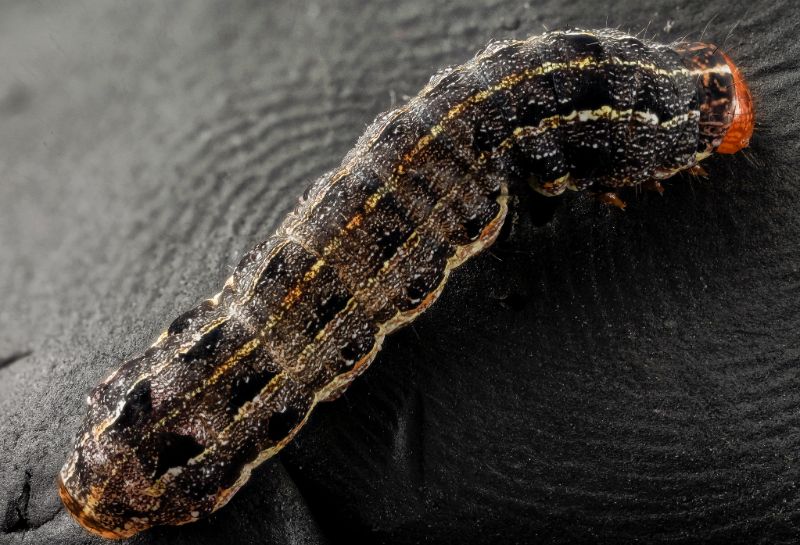
USGS Bee Inventory and Monitoring Lab | Flickr | Public domain
What are armyworms?
Armyworms are caterpillar-like larvae of fuzzy brown moths. Their name originates from the way they’ll overrun your lawn in mass armies, destroying any turf and plants in their way.
There are several species of armyworms. They’re all striped and they range in color from brown to yellow, red, and green. They’re typically 1–2 inches long.
Like many insects, armyworms have four life stages: egg, larvae, pupa, and adult. Each year, armyworms will produce three generations of larvae.
- First generation: April-May
- Second generation: June-July
- Third generation: August-September
Signs of an armyworm problem
Armyworms are most destructive when in their larval stage, which is when they strip away and eat your grass stems and blades. They might also eat leaves on your other plants, like ornamental plants or vegetables.
By the time armyworms have infested, it’s usually too late to get the damage under control. If you suspect an armyworm invasion, look for signs such as:
- Circular bare patches
- Overnight destruction
- Brown patches surrounded by healthy turf
- Transparent-looking grass blades
- More birds feeding on your lawn than usual
Armyworms typically attack Kentucky bluegrass, tall fescue, fine fescue, Bermudagrass, and ryegrass. They are particularly prominent in the South.
Most armyworms are spotted in lawns in late summer, but outbreaks have been reported as early as April in some cases.
How to check for armyworms:
See if armyworms are infesting your lawn with a simple soap flush test. Create a mixture of 3 tablespoons of dish soap and 1 gallon of water. Combine, and pour over any patches that appear infected. Within a few minutes, armyworm larvae should rise to the surface.
It’s best to attempt the soap flush test at night when armyworms are most active. If you count more than three armyworms per square foot, it’s time to take action.
How to get rid of armyworms
If armyworms are a common pest in your area, it’s important to take protective measures for your lawn. Get rid of armyworms with one of two organic methods: nematodes or Bacillus thuringiensis.
Nematodes are an organic option, which can help get rid of more than 200 kinds of turf pests. These microscopic worms deal with pests by hunting them down and releasing toxins to kill them. Species that specifically target armyworms include Steinernema carpocapsae, Heterorhabditis bacteriophora, and Heterorhabditis indica.
Bacillus thuringiensis (Bt) is another organic pest control method. Bt is a microbe that makes toxic proteins that target insect larvae. It doesn’t harm the environment because it naturally occurs in the soil.
You can prevent the armyworm militia from marching to another section of your yard by using an insecticide to create a border around your infested turf. The most effective insecticide contains the ingredient halofenozide.
How to prevent armyworms
Armyworms are attracted to yards that have overgrown grass and weeds. Prevent armyworms from invading your lawn by:
- Mowing your lawn
- Keeping your lawn watered
- Removing weeds
- Keeping the grass short
- Dethatching
- Checking monthly for armyworms
- Using preventative pesticides
Armyworms have some natural predators, like flies, ground beetles, skunks, and birds. Try attracting more birds to your yard and see if that helps keep armyworms and other pest populations down.
2. Fleas

Erturac | Wikimedia Commons | CC BY-SA 3.0
What are fleas?
Fleas are annoying little pests that are particularly bothersome to your furry friends. They are tiny blood-sucking insects that jump around and can transmit disease to animals and humans. Fleas are around 1/12 inch long, with six legs, and are black or brown in color. They can jump up to 200 times their body length (13 inches).
Flea bites are not only itchy, irritating, and lead to hair loss, but they also can transmit diseases and tapeworms to your precious pets. Most homeowners are dealing with “cat fleas,” which can leech onto dogs, cats, humans, and other animals.
Signs of a flea problem
If you have fleas in your lawn, you might not notice until you or your pets have carried some fleas into your home. Look out for:
- Your pet itching nonstop after playing outside
- Miniscule flea dirt, which looks like tiny black dots, on top of indoor and outdoor surfaces
- Flea bites, which are typically rows of red bites below the knee
- Fleas crawling on your pet
- Fleas clinging onto your arm or leg hair, pants, or other articles of clothing
How to check for fleas:
Use the white sock test to see if fleas have infested your lawn. Wear a pair of knee-length white socks and go for a walk around your backyard. If fleas are jumping around your yard, you should see a few of them clinging onto your socks.
When you’re done, place the socks in a plastic bag or sealed container and toss them into your outdoor trash can.
How to get rid of fleas
Thankfully, there are a few ways to get rid of fleas and prevent them from jumping on you or your pets in the first place.
Nematodes can be helpful for targeting fleas, in addition to many other pests. Once you follow the nematode instructions and introduce them to your yard, you should notice fewer fleas in your yard within 24 hours.
Diatomaceous Earth (DE) might not work as quickly, but it is another option that targets fleas.
How to prevent fleas
Fleas thrive in warm, humid weather, particularly when temperatures are around 75 degrees. They can pop up at any time of year, but are most prevalent in the summer from June to September. They also tend to gather in shaded spots.
- Make sure you give your pet flea medication throughout the year
- Reduce shade by trimming bushes and trees
- Water infrequently
- Keep your grass at an ideal height
- Dethatch your yard
- Remove debris
- Use cedar mulch, which naturally deters fleas
- Plant flea-repelling plants
3. Sod webworms
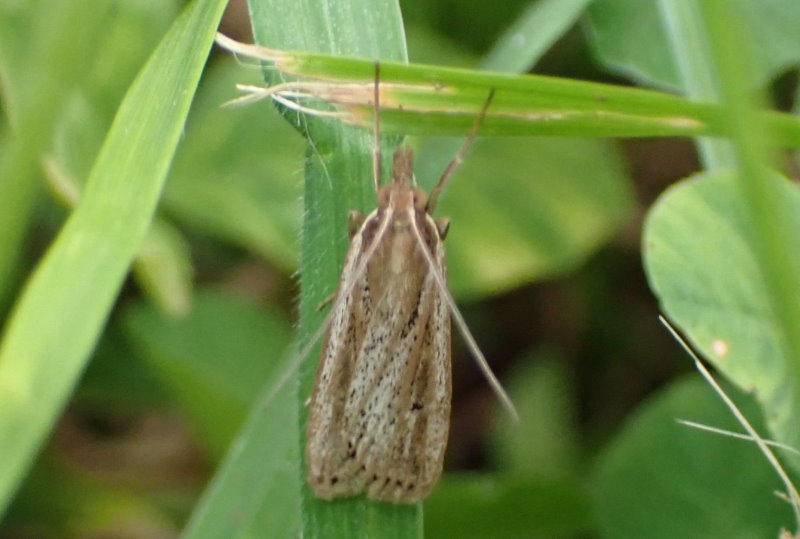
Sean Clifford | Wikimedia Commons | CC BY-SA 4.0
What are sod webworms?
Sod webworms are little caterpillars that build silky tunnels in your lawn to hibernate through the winter. They are the larvae of more than 20 species of close-winged moths. Sod webworms are brown and green with brown heads and dark spots.
Watch out for sod webworms in their larvae stage, which is when they’re around an inch long. This is when they’ll cause the most damage to your turf. Sod webworms begin as eggs, then go through six larval stages before pupating and reaching adulthood.
There are three generations of sod webworms throughout the year:
- First generation: May-June
- Second generation: July-August
- Third generation: September
Signs of a sod webworm problem
Sod webworms can quickly damage your turf. They eat your grass, particularly the grass stems and leaves. They’re attracted to lawns with abundant thatch, especially in dry, warm weather, which is why they’re more commonly a problem in the South.
Damage caused by sod webworms can often be confused for dormant grass or drought stress. If you think you might have a sod webworm infestation, look for:
- Shortened patches of grass
- Silk webbing
- Dead grass
- Brown patches
- Scalped grass
- Webworm feces (tiny green pellets)
How to test for sod webworms:
Combine ¼ cup of household detergent with 2 gallons of water. Pour this solution over a 3-foot patch of your lawn that appears to have sod webworm damage. If your lawn is infested, the webworms should appear at the top of your lawn within 10 minutes.
If you count more than 15 sod webworms, it’s time to take action.
How to get rid of sod webworms
The most recommended natural method for dealing with sod webworms is to use parasitic nematodes, like Steinerenema.
Pesticides are not recommended for treating sod webworms because they often kill other beneficial insects. Try not to use chemical pesticides unless you count more than 15 sod webworms per square yard. If it’s a serious infestation, use insecticides that contain bifenthrin.
How to prevent sod webworms
No yard is safe from sod webworms because they will infest any grass type. Make your yard look less inviting to them by:
- Dethatching annually
- Mowing the lawn regularly
- Keeping the grass trimmed short
- Watering your lawn regularly
- Deeply raking your lawn
4. Chinch bugs

PxHere
What are chinch bugs?
Chinch bugs are little, but they can cause mighty damage. These black insects are often hard to see since they’re smaller than ¼ inch.
They go through three life stages: egg, nymph, and adult. Chinch bug nymphs are red and turn black once they reach adulthood. Adult chinch bugs have a signature mark — an X-shape — on their backs.
Chinch bugs gather in the thatch layer and can be seen on top of grass leaves when your yard is infested. They are typically found near hot surfaces, like driveways, sidewalks, and any other hardscaping that bakes in the hot sun.
Chinch bugs cause the most damage in the summer months, especially July and August.
Signs of a chinch bug problem
Chinch bug damage is commonly confused with other lawn issues like drought and brown patch. Be sure to check for chinch bugs and note all the symptoms to distinguish the problem.
Look for signs of:
- Slowed or stunted turf growth
- Dead patches of grass
- Irregular brown spots
- Drought symptoms
- Increase in weeds
- Rapid damage
How to check for chinch bugs:
Grab a magnifying glass and a flat, white sheet of paper. Dig around in an area that seems infested, and use your magnifying glass to look for chinch bugs. It may be helpful to hold the sheet of paper behind grass blades to more easily see these minuscule insects.
Another chinch bug test is the tin can method. Cut both ends off of a tin can. Locate a section of your yard that has both dying and healthy grass. Insert one end of the can into a section where the dying and healthy grass meet. Use water to fill the other end of the can, then wait for 10 minutes. If chinch bugs have infested your lawn, they should float up to the surface.
How to get rid of chinch bugs
Chinch bugs can be very challenging to get under control. The most recommended natural method is diatomaceous earth (DE), which will cause chinch bugs to dehydrate and die once they come into contact with DE.
Chemical solutions include broad-spectrum pesticides that include trichlorfon, bifenthrin, or carbaryl. Carefully follow all instructions on the package: Mishandled pesticides can be very dangerous to you, your family, and your pets.
Don’t be afraid to rely on a professional for assistance.
How to prevent chinch bugs
Chinch bugs are most attracted to lawns with warm-season grass. They’re particularly drawn to St. Augustine grass and have been known to infest Bermudagrass, bahiagrass, centipedegrass, and Zoysiagrass, as well. Because they’re drawn to heat, these pests are a big problem in the South.
Chinch bugs can infest Florida lawns year-round and are a constant battle for homeowners in the Gulf Coast region. Outside of the Sunshine State, chinch bugs are most likely to pop up between April and October.
Warm climates and drought conditions also can decrease the number of ants and ladybugs, which are natural predators to chinch bugs. Try not to harm these insects if you regularly experience chinch bug infestations.
5. Stink bugs

Ton Rulkens | Wikimedia Commons | CC BY-SA 2.0
What are stink bugs?
The brown marmorated stink bug is an invasive, annoying, and smelly species. They are brown with six legs, an antennae, and a shield-like shell. They release an odor when frightened (and killed), and make a buzzing sound when they fly. They can grow up to 2 cm long.
Stink bugs are particularly annoying when they invade your home in an attempt to stay warm for the winter, but they also can cause extensive damage to your fruit trees and vegetable garden.
Signs of a stink bug problem
Stink bugs can mate multiple times in the year, resulting in up to three new generations of stink bugs (especially in warmer climates). These pests are a serious problem for fruits, ornamental plants, and garden crops. The terror will seemingly never end because they release scents to attract more stink bugs.
- Foul odor
- Fruits and vegetables that appear bruised and discolored
- Small, circle-shaped scars on fruit and vegetables
- Plants, especially fruit-producing plants, appear damaged
- Plants have yellow or green discoloration surrounding pinprick marks
How to get rid of stink bugs
Stink bugs are resistant to most common pesticides, so it might be a good idea to rely on a professional. You can try your hand with organic pest control methods like neem oil, pyrethrin, and insecticidal soap.
Another option is to spray plants with kaolin clay, a natural mineral that is safe to sprinkle on and around your edible plants and can easily be washed off.
Stink bugs do not attract more stink bugs when killed, so don’t be afraid to get out the electric fly swatter when you hear or smell them near you.
How to prevent stink bugs
Stink bugs were first found in Pennsylvania in 2001, and have been spreading ever since. They’re most prevalent along the East Coast, but they can be found in 44 states.
- Keep your yard clear of debris
- Remove all weeds
- Seal windows and doors to prevent them from turning your house into their home
Encourage natural predators like ladybugs, spiders, toads, birds, and praying mantis to live in your yard.
If stink bugs are a recurring problem, consider planting “trap plants,” or plants that stink bugs will be drawn to instead of your prized veggies. Stink bugs are most attracted to mustard, okra, sunflower, amaranth, and sweet corn.
6. Cutworms

Sarah Zukoff | Flickr | CC BY 2.0
What are cutworms?
Cutworms are smooth caterpillars that get their name from the way they’ll cut down and kill your sprouting plants and turfgrass. Cutworms spend most of the day burrowing under your turf and come out after sundown to feast on your grass. Most cutworms are about 2 inches long with spots or stripes and brown or gray-colored bodies.
They feed on your turfgrass and will produce between two and six generations per year. They’re most commonly found in the spring but can destroy your lawn throughout the year. Cutworms have four life stages: egg, larvae, pupa, and adult. As adults, they are black and brown-colored moths.
Signs you have a cutworm problem
It can be hard to tell if cutworms are to blame for your lawn and garden damage since they’re most active at night. Cutworms will destroy your turf and vegetables like peppers, carrots, lettuce, tomatoes, and potatoes.
Cutworm damage looks like:
- Caterpillar burrows dotting your lawn
- Wilting grass blades
- Shortened grass
- Grass cut down to the base
- Destroyed plant seedlings
- Wilting vegetables
How to check for cutworms:
Dig into an infected area of your lawn after sundown. Feel free to throw on some gardening gloves, and sift around the soil to find these curly caterpillars (they’ll curl up into a C-shape when disturbed).
How to get rid of cutworms
The easiest way to get rid of cutworms is by hand. Simply scoop them out of infected soil and drop them in a container of soapy water.
You also can try other organic pest control methods like diatomaceous earth (DE), Bacillus thuringiensis, and nematodes.
The recommended chemical pesticide is cutworm bait, which you can put around your new seedlings to protect them from being destroyed. You also can try pesticides targeting cutworms, just make sure to apply them after sundown.
How to prevent cutworms
Cutworm caterpillars love yards with a lot of thatch and tall weeds and grass leaves where they can lay their eggs. To prevent these pests from taking over your yard, be sure to:
- Keep your grass on the shorter side
- Keep your yard weed-free
- Dethatch annually
- Aerate annually
- Mow your lawn regularly
- Remove debris and dead plants
You also can use dry soil to create an uninviting border around your vegetable garden. Always be sure to till your garden each year before planting to check for larvae and burrowing pests like cutworms.
7. Ants
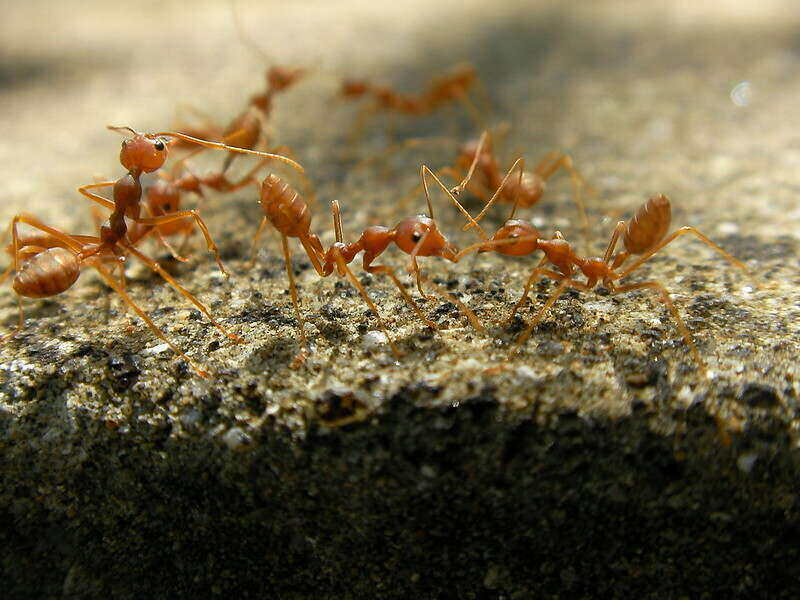
Marufish | Flickr | CC BY-SA 2.0
What are ants?
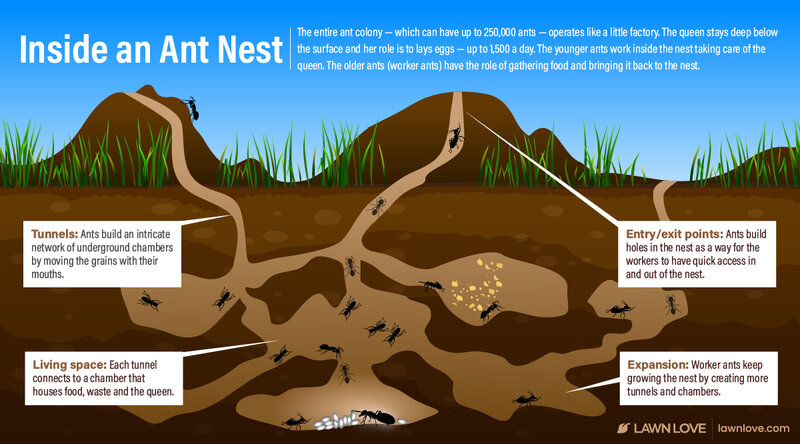
Ants are so common that you might not even consider them pests until their anthills make mowing your lawn feel like a monster truck rally. These small insects have six legs, antennae, and come in a variety of species, including:
- Carpenter ants
- Fire ants
- Mound-building ants
- Pavement ants
In addition to making lawn chores even more of a hassle, many ants can bite you and your family and are likely to find their way into your home and kitchen.
Signs of an ant problem
Most of the time, you shouldn’t be worried if you see an anthill or two in your backyard. You might be concerned if you notice:
- Ants marching into your home
- Multiple anthills across your lawn
- Many ants crawling around food and trash next to your home
How to get rid of ants
If you’re dealing with a yard full of anthills, it’s time to get armed and fight to regain control of your lawn.
Use a mixture to drown out the anthills:
- Combine equal parts boiled water and dish soap or water and vinegar
- Use a rake to open the anthill
- Pour the mixture into the hole
Use a hose to flood out the anthills:
- Soak anthills with a hose for 30 minutes
- Repeat 24 hours later
Other natural pest control methods to try are diatomaceous earth, borax, baking soda, and white vinegar. If none of these work, you can try chemical solutions. The most effective chemical pest control option for dealing with ants is broadcast bait. Broadcast bait attracts ants and causes them to bring the poison back to the anthill to share with the queen and her colony.
Apply broadcast bait in the morning or evening when the weather is cool but dry. Check ahead to see that the next few days are clear as well since rainstorms will wash the broadcast bait away.
Avoid using contact chemicals, which only kill the ants that come into contact with it.
How to prevent ants:
Keep ants out of your pants by:
- Covering your compost bin and trash cans
- Placing trash, debris, and discarded food in closed-off containers
- Freshly sealing your doors and windows with caulk
- Using broadcast bait to get ant colonies under control
- Spraying ant-killer around hardscaping or your home’s foundation
8. Grubs

Pixabay
What are grubs?
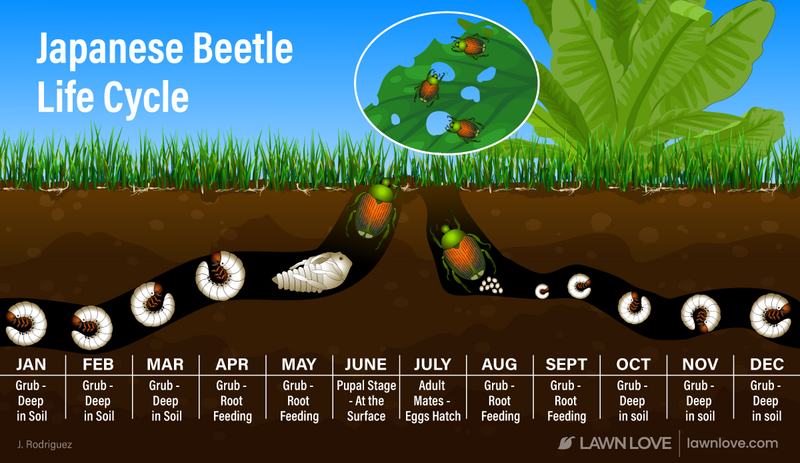
Grubs, known as “nature’s dethatchers,” are the larvae of scarab beetles. These common lawn pests are white-colored wormlike creatures that wiggle around in your thatch and soil and feast on the roots of your grass. They form a C-shape, have a brown head, and are typically around an inch long. Some grubs have legs, but not all.
Common scarab beetle species are:
- Japanese beetles
- Masked chafers
- European chafers
- Billbugs
- June bugs, AKA May beetles
Most beetle eggs hatch in late summer, unleashing the white grubs on your precious turf. In truth, a few grubs in your lawn are fine, and can even be helpful if you have a bit of thatch. If there are too many grubs you’re likely to see some lawn damage in August and September. You might not see the lawn grubs themselves, since they are hidden in the soil and thatch layers.
Grubs eventually will evolve into adult beetles, which aren’t as harmful as they are in their adolescent form.
Signs you have a grub problem
Grubs are commonly found in lawns across the country. When grub populations get too big, they’ll eat your grass roots, and kill patches of your lawn.
Common signs of a grub problem include:
- Patches of brown, dead grass
- Wilting grass
- Dry patches of grass
- Spongy turf
- Turf lifting up easily
- Holes in the ground dug by wildlife
A lot of grub-related damage can come from wild animals burrowing into the ground to eat them. Keep an eye out for skunks, raccoons, crows, and armadillos digging in your yard.
How to check for grubs:
Use a shovel or lawn edger to cut a square foot (frisbee-sized) section of your lawn. Peel back the grass, and use your hand to dig around up to 3 inches of the soil. Count the number of grubs you spot.
You shouldn’t worry unless you count 5-7 grubs. If you find 10 or more grubs, you’ll want to get rid of them as soon as possible.
How to get rid of grubs
Common natural grub-control methods include unleashing nematodes and milky spore. Milky spore is specifically for Japanese beetle grubs, and can only be used in USDA Zones 7-10. Nematodes can be found in your local hardware stores or ordered online.
Avoid using pesticides unless grubs are seriously infecting your lawn (10 or more grubs per square foot). More than 70% of grub treatments are proven to be useless. In June, use chemical pesticides containing:
- Clothianidin
- Thiamethoxam
- Imidacloprid
Pro Tip: Protect pollinators by mowing the lawn right before applying pesticides.
How to prevent grubs
If grubs seem to appear in your lawn year after year, leaving patches of dead grass in their wake, then you should consider implementing a grub prevention plan.
- Apply preventative pesticides in early to mid-June
- Plant drought-resistant grass and water it as little as possible
- Encourage root growth by fertilizing October-November
Lawn grubs can infest many grass types. May beetles are most likely to infest cool-season grasses like fine fescue, tall fescue, ryegrass, and Kentucky bluegrass. June beetles and masked chafer bugs typically target warm-season lawns like St. Augustine, Zoysiagrass, buffalograss, and Bermudagrass.
9. Ticks
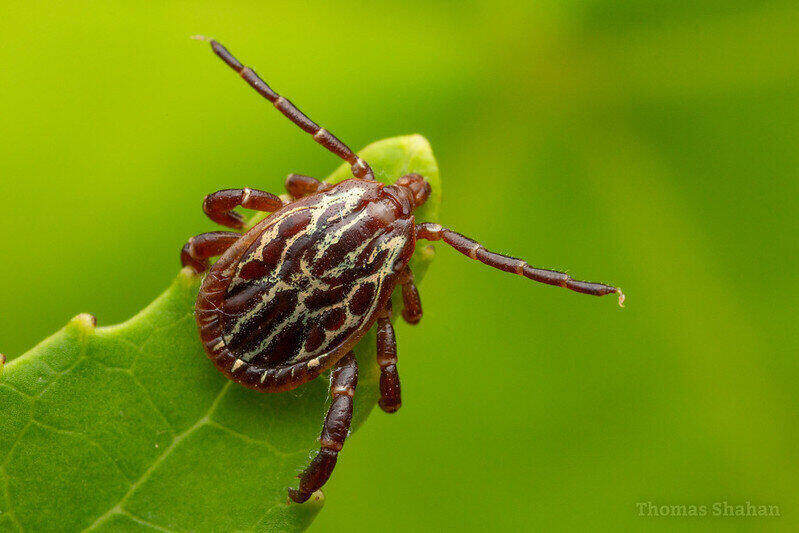
Thomas Shahan | Flickr | CC BY 2.0
What are ticks?
Ticks are extremely small pests that are a threat to the health of your lawn, your pets, and you and your family. Many people don’t notice they have a tick bite until they see their tiny, oval-shaped body sticking out of their skin.
Ticks are flat insects with eight legs. They tend to be around 3/16 inches long and can fatten after feeding on blood. Ticks are a health threat since they carry Lyme disease and other illnesses like Rocky Mountain spotted fever.
Always check for ticks after spending a lot of time outdoors, especially if you were around tall patches of grass or forested areas.
The most common ticks you might encounter include:
- Deer tick
- American dog tick
- Brown dog tick
- Rocky Mountain wood tick
- Lone star tick
- Gulf Coast tick
Signs of a tick problem
Ticks can go by unnoticed, so you must check carefully after returning from an outdoor adventure. Check behind your knees, your armpits, behind your ears, and anywhere you might have body hair they could easily latch on to. Use tweezers to carefully remove any you find. Keep an eye out for a rash or fever for a couple of weeks, and consult a doctor if symptoms develop.
Ticks can commonly be found in or around:
- Tall bushes
- Piles of firewood
- Thick vegetation
- Forested areas
- Plant debris
- Tall grass and plants
How to get rid of ticks
You can’t really extinguish ticks from your yard, but you can use different methods to deter them from where your precious pup plays. Remove anything that attracts ticks, then try sprinkling diluted eucalyptus oil or cedar oil near your yard.
An acaricide (tick pesticide) can help reduce the number of ticks in your yard if you notice a particularly pesky infestation.
How to prevent ticks
Ticks can be found anywhere in the U.S., and have unfortunately carried Lyme disease with them. Be alert whenever you spend a lot of time outside, and check your pets regularly.
Deter ticks from your yard by:
- Mowing regularly
- Keeping piles of wood in dry, neat stacks
- Removing all litter and debris from the yard
- Swiftly removing piles of leaves
- Building a fence around your backyard to keep out wildlife
- Install human hangout and pet play areas away from the border of your yard
- Use gravel or wood chips to form a barrier around your yard
10. Aphids

stéphane gonzalez | Flickr | CC BY 2.0
What are aphids?
Aphids are soft-bodied insects with two distinguishable “tailpipes” trailing off their abdomen. These insects have an odd mating process: female aphids reproduce live offspring in the summer, without any help from a male mate. Then, in the fall, male and female aphids will mate together. The female aphid will lay eggs to hatch and restart the cycle in the spring.
Mature adult aphids usually have wings and pear-shaped bodies. They range in color from gray, brown, and black, to red, green, and yellow. They’re tiny insects, typically ranging from 1/16 to ⅛ inches long.
Signs of an aphid infestation
Aphids are not a rare sight, but in large numbers, they can cause a lot of problems, especially for avid gardeners. Other than seeing the bugs with your own eyes, you might notice signs of:
- Sooty mold
- Honeydew secretions
- Yellow foliage
- Curling or twisted leaves
- Dead plant shoots
- Stunted plant growth
- Plant viruses (misshapen, mottled, or yellowed leaves and produce)
Aphids don’t typically cause a lot of damage from nibbling on your plants, but they secrete honeydew, which can lead to sooty mold growth on your trees.
How to get rid of aphids
Usually, aphids are no cause for alarm. If you see them crawling around a plant, you can easily spray them off with a hose or spray them into a container with soapy water. They aren’t very strong, so hose spray will quickly knock them away.
If aphids are wreaking havoc in your garden, try using neem, insecticidal soap, pyrethrins, or horticultural oil.
How to prevent aphids
Aphids are attracted to plants with high levels of nitrogen and are known to feast on spinach, cabbage, and asparagus. They also will attack shrubs and trees such as peach, pecan, hibiscus, and hydrangea.
Deter aphids from entering your backyard sanctuary by:
- Planting chives, garlic, and onions
- Removing all weeds
- Not over-fertilizing your plants
- Allowing natural predators like ladybugs to live peacefully in your yard
11. Mole crickets

Pixnio
What are mole crickets?
Mole crickets aren’t the prettiest pests. As adults, they’re 1 to 2 inches long, with six legs, long antennae, and a pair of wings. Mole crickets dig tunnels under your lawn, disrupting your growing grass. These insects feast on the roots and leaves of your grass, causing drought-like symptoms and patches of brown, dying grass.
Mole crickets tend to cause the most damage in the spring between February and June, and the early fall during September and October. They can be active year-round in hot regions like Florida.
Signs of a mole cricket infestation
Mole crickets can cause devastating lawn damage, especially in high populations. Look out for:
- Root rot
- Irregular brown patches
- Drought symptoms
- Mounds of dirt striping your lawn (from mole cricket tunneling)
- Weak grass roots
- Grass pulling up from the ground easily
How to check for mole crickets:
To see if mole crickets are really to blame for your lawn damage, use a simple dish soap test. Mix together 1 gallon of water with 1-2 ounces of dish soap. Locate about 2 square feet of your yard that seems infested. Pour the mixture over this area and wait to see if any mole crickets emerge.
How to get rid of mole crickets
The best natural control method for mole crickets is inviting nematodes into your lawn. You also can rely on chemical options like mole cricket baits and insecticides that contain:
- Imidacloprid
- Bifenthrin
- Permethrin
- Beta cyfluthrin
- Clothianidin
- Trichlorfon
How to prevent mole crickets
Mole crickets tend to target lawns in the Southeast. They’re less commonly found in grass types like Bermudagrass and fine fescue, so consider planting these grasses if they grow in your region and mole crickets are an annual problem for you.
Other ways to prevent mole crickets from taking over your lawn include:
- Keeping your turf strong and healthy
- Encouraging grass roots to grow long and strong
- Applying long-term insecticides
12. Spittlebugs

Pavel Kirillov | Wikimedia Commons | CC BY-SA 2.0
What are spittlebugs?
Spittlebug is an apt name for these insects, which excrete eggs covered in foamy spit all over your plants. Their spittle keeps nymphs protected from both predators and extreme weather conditions.
Relatives of aphids, these bugs are brown or gray-colored and evolve into adult insects with wings and bright stripes.
As adults, spittlebugs can be called froghoppers and are known to jump great distances. By the time summer rolls around, most spittlebugs are in their adult form, continuing to feed and laying more eggs at the end of the season. These eggs will hatch in the spring and start the life cycle all over again.
Signs of a spittlebug infestation
Spittlebugs aren’t destructive like other pests, but they can be gross guests to have in your yard — especially if you’re growing a prize-winning vegetable garden. The last thing you want is your precious pea plant covered in spittle.
Keep an eye out for spittlebug foam every couple of weeks. You might see the usual trail of spittle, or you might notice your plant leaves and stems feel sticky to the touch.
How to get rid of spittlebugs
Do not attempt to control spittlebugs with chemical pesticides. Not only is it useless, since their spittle foam protects nymphs from pesticides, but spittlebugs don’t cause enough damage to warrant a chemical attack. Spittlebugs move quickly from plant to plant in tiny populations, and should not be a cause for concern.
It’s normal to be grossed out by these spit-producing insects, so if you want to rid them from your garden, try the following:
- Use a hose to spray them off your plants
- Remove them by hand
- Drown spittlebugs in soapy water
How to prevent spittlebugs
Spittlebugs are attracted to weeds and nitrogen-fixing plants (such as legumes), so keep these out of your yard. Remove invading weeds, especially if they’re close to your garden. Spittlebugs also can feast on weeds, grass, and garden plants.
How to revive your lawn post pest control
One of the most irritating aspects of dealing with pests is the expensive damage they cause in your lawn and garden. Get your lawn back to normal with some TLC. Some key tasks to help your lawn bounce back from pest damage are:
- Overseeding your lawn
- Aerating (if possible)
- Raking away dead grass
- Mowing to stimulate new growth
- Watering your lawn
FAQ about summer lawn pests
Avoid harming beneficial insects, like:
–Bees
–Butterflies
–Ground beetles
–Ladybugs
–Praying mantis
–Spiders
These creatures might be unsightly or disturbing to you, but they play a big role in keeping these harmful pests under control.
A lot of summer pests will continue to cause damage into fall. This is true for grubs, chinch bugs, armyworms, cutworms, and sod webworms, to name a few.
Be sure to keep up with your yard. Try to maintain a healthy lawn by:
–Raking away debris
–Watering deeply and encouraging strong roots
–Mowing regularly
–Aerating every year or so
–Dethatching cool-season grass in the fall
–Keeping up with your fertilization schedule
Pollinators like bees and butterflies are beneficial insects that help your garden thrive and protect it from harmful insects like those listed above. Encourage these insects to call your backyard paradise home by:
–Planting native plants
–Providing shelter
–Creating watering stations
–Planting bee-friendly plants
–Planting butterfly-friendly plants
Put up a fight against those pesky pests with the power of a local pest control expert. If you need help with keeping pests away with mowing and weeding, rely on a local Lawn Love professional.
Main Photo Credit: Stinkbug | Pixabay